Are you considering building a dating app tailored for the LGBTQ community?
With inclusivity becoming a driving force in the tech world, LGBTQ dating apps are bridging gaps in traditional platforms.
These apps are more than just tools for matchmaking, they’re safe spaces where individuals can express themselves authentically and connect with like-minded people.
The demand for LGBTQ-specific apps is growing as users seek platforms that respect their identities and offer personalized features.
Whether you're looking to develop a dating app for LGBTQ or explore the steps to create a LGBTQ dating app, this guide has everything you need to know.
Let’s explore how you can make a meaningful impact in this thriving market.
Here’s What LGBTQ Dating App Market Offers
Developing a dating app tailored for the LGBTQ community requires understanding the unique dynamics and trends within this market.
Recent studies provide valuable insights into user behaviors and preferences:
-
- Approximately 51% of lesbian, gay, or bisexual (LGB) adults have used online dating platforms, compared to 28% of straight adults.
- About 24% of partnered LGB adults met their current significant other through a dating site or app, highlighting the effectiveness of these platforms in facilitating meaningful connections.
- Among LGB online daters, 55% have used Tinder, while 6% have used Grindr, indicating distinct preferences for specific apps within the community.
- Around 61% of LGB online daters report their experiences as very or somewhat positive, suggesting a generally favorable reception of these platforms.
- A significant 56% of LGB online daters have encountered some form of harassment on these platforms, underscoring the importance of robust safety features.
- Younger adults, particularly those aged 18 to 29, are more likely to use online dating platforms, with 53% reporting usage, compared to 37% of those aged 30 to 49.
These statistics highlight the critical role of online dating in the LGBTQ community and emphasize the necessity for inclusive, secure, and user-friendly platforms. By integrating advanced safety measures and catering to user preferences, developers can create apps that resonate with and effectively serve the LGBTQ audience.
What’s an LGBTQ Dating App?
An LGBTQ dating app is a platform designed specifically for the LGBTQ community.
It provides features that respect and celebrate diverse gender identities and sexual orientations.
Unlike traditional dating apps, these platforms prioritize inclusivity and user safety.
Core Focus:
- Building connections in a judgment-free environment.
- Offering features like customizable gender options and orientation filters.
Why Are They Unique?
- They address the unique challenges LGBTQ individuals face on mainstream dating apps.
- Safety measures are more robust, with advanced reporting and anti-harassment tools.
These apps go beyond dating, they create spaces for friendships, networking, and even community building.
Whether you're exploring how to create an LGBTQ dating app or planning to build one, understanding these nuances is crucial for success.
LGBTQ Dating App vs. Traditional Dating App
The differences between LGBTQ dating apps and traditional ones are critical to understand for a successful app development strategy.
Here’s a detailed comparison:
|
Aspect |
LGBTQ Dating App |
Traditional Dating App |
|
Inclusivity |
Offers a wide range of gender and orientation options. |
Limited to binary gender choices and heterosexual matches. |
|
Safety Features |
Advanced moderation, reporting tools, and privacy controls. |
Basic safety features; lacks tools for addressing LGBTQ-specific issues. |
|
Community Focus |
Builds a sense of belonging and fosters LGBTQ networking. |
Lacks dedicated community-building features. |
|
Matching Algorithms |
Tailored to LGBTQ preferences, identities, and unique dynamics. |
Generalized algorithms with limited LGBTQ-specific optimization. |
|
Cultural Sensitivity |
Inclusive language and prompts to support identity expression. |
Standard language that may alienate LGBTQ users. |
|
Social Features |
Includes community events, forums, and group activities. |
Focused on one-on-one matching without broader social elements. |
|
User Retention |
Higher due to personalized features and safe spaces. |
Retention lower for LGBTQ users due to a lack of inclusivity. |
Why This Matters
Understanding these distinctions helps you build a platform that not only attracts LGBTQ users but also meets their unique needs.
Best LGBTQ Dating Apps
When you create a dating app for LGBTQ users, understanding what works in the current market is crucial.
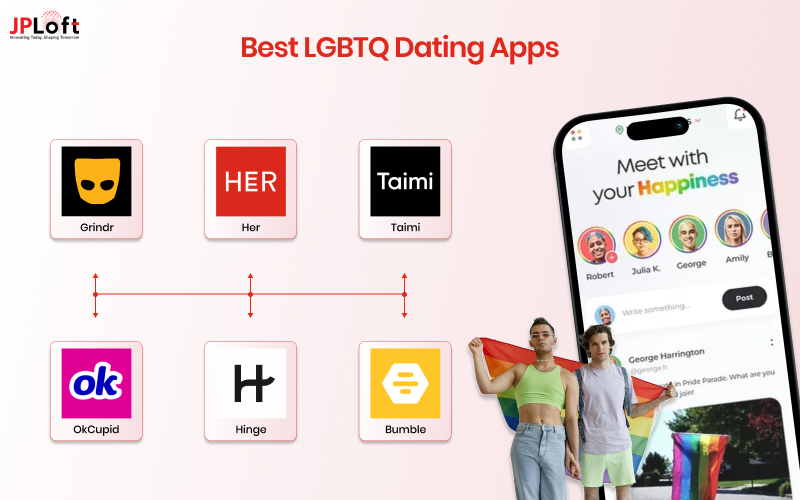
Here’s a detailed analysis of the best apps and their standout features
1. Grindr
Grindr is a trailblazer in LGBTQ dating apps, catering to gay, bi, trans, and queer individuals.
It’s widely recognized for its ease of use and quick, location-based connections, making it perfect for casual relationships.
- Location-based matching for immediate and nearby connections.
- Customizable profiles with options for photos, interests, and preferences.
- Secure messaging with optional media and photo sharing.
2. Her
HER is designed for LGBTQ women and non-binary individuals, offering a safe and inclusive space.
Unlike traditional apps, HER focuses on building a sense of community alongside facilitating meaningful connections.
- Event-based features to help users connect in real life.
- Social networking options through a news feed to foster conversations.
- Robust privacy settings to ensure user safety and comfort.
3. Taimi
Taimi goes beyond just dating by combining it with social networking.
It’s a versatile app that enables users to engage with others through live streaming, posts, and an LGBTQ-friendly social feed.
- A dedicated social feed for connecting over shared interests.
- Live streaming to foster real-time interaction among users.
- Built-in tools for ensuring safety, like identity verification.
4. OkCupid
OkCupid is a popular dating app that has made strides in inclusivity by offering detailed questionnaires and supporting a broad spectrum of gender identities and sexual orientations.
It’s perfect for users seeking meaningful relationships.
- Algorithm-driven matching based on compatibility scores.
- A wide range of gender and orientation options to cater to inclusivity.
- Engaging prompts to help users express themselves better.
5. Hinge
Hinge focuses on building serious, long-term relationships, making it stand out from casual dating apps.
Its engaging profile prompts and compatibility-driven algorithms cater to the LGBTQ community effectively.
- Conversation-starting prompts for better engagement.
- Tailored matches based on preferences and shared interests.
- Options for specifying relationship goals clearly.
6. Bumble
Bumble creates a unique experience for LGBTQ users by allowing anyone to initiate conversations, breaking away from the gendered norms of traditional dating apps.
It also offers modes for networking and friendships.
- Multiple modes for dating, networking, or friendship connections.
- Inclusive design, welcoming all gender identities and orientations.
- Advanced profile settings to customize preferences.
Should You Develop an LGBTQ Dating App in 2025?
Developing a dating app for LGBTQ users in 2025 isn’t just a business decision, it’s a strategic opportunity in a growing and underserved market.
Here’s why now is the perfect time to invest:
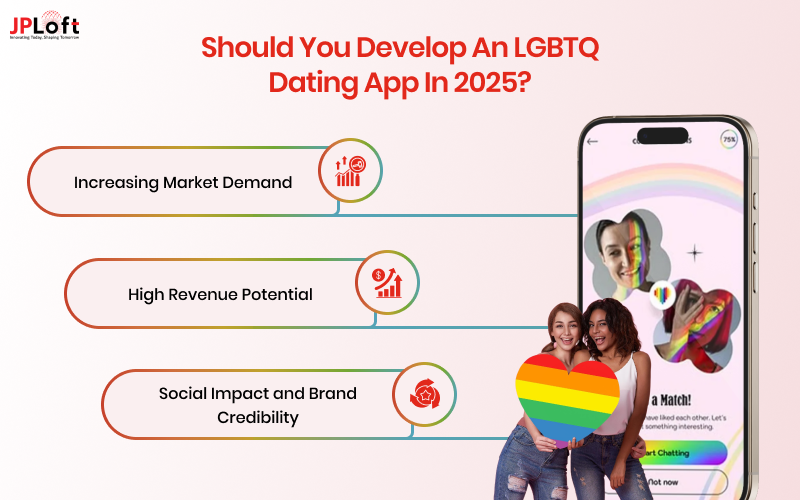
► Increasing Market Demand
The LGBTQ dating app industry is expanding rapidly.
Users are shifting away from traditional dating apps that fail to meet their unique needs.
Many LGBTQ individuals prefer platforms where they can express their identities freely and feel included.
With annual growth rates of approximately 12% in LGBTQ-specific dating platforms, there’s an undeniable demand for more inclusive, personalized options.
By creating an LGBTQ dating app, you can fill this gap and cater to a loyal and engaged user base.
► High Revenue Potential
The dating app market is projected to reach $10.87 billion globally by 2024.
LGBTQ dating apps often see higher retention rates and user engagement compared to mainstream apps.
Revenue streams include premium subscriptions, in-app purchases, targeted advertisements, and event sponsorships.
Apps that offer value-added services like matchmaking insights or safety tools can command higher subscription rates.
The combination of high demand and diverse monetization options makes LGBTQ dating apps a lucrative venture.
► Social Impact and Brand Credibility
Investing in an LGBTQ dating app showcases your commitment to inclusivity and equality.
Brands that align with user values, particularly in the LGBTQ space, often see stronger loyalty and advocacy.
Creating a safe, respectful space for LGBTQ individuals enhances your social credibility.
It’s an opportunity to do more than just generate profits, you contribute to building a supportive community.
Businesses with a focus on social impact often attract attention from media and investors, adding further credibility to your venture.
With these compelling reasons, 2025 offers the perfect landscape to build a dating app that combines profitability with purpose.
Steps To Create LGBTQ Dating App
Building a LGBTQ dating app requires a structured approach.
Each phase plays a critical role in ensuring the app meets user expectations while standing out in a competitive market.
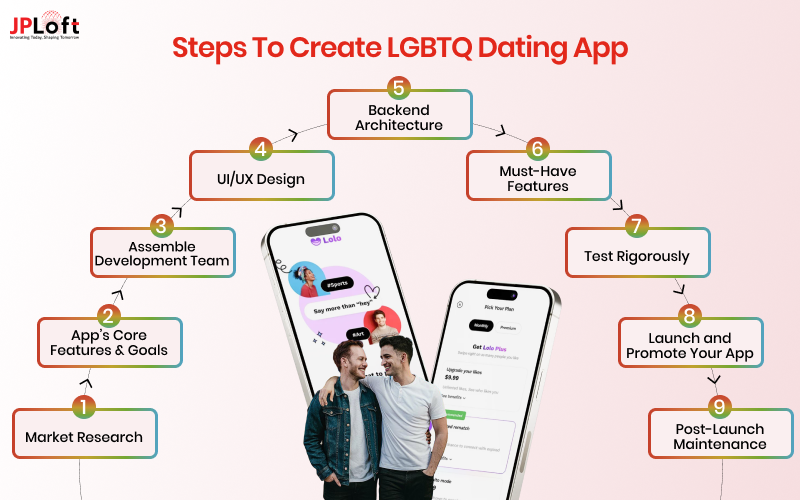
Let’s break it down in detail:
Step 1: Conduct Comprehensive Market Research
Begin by understanding the unique needs and challenges of LGBTQ users.
Explore existing LGBTQ dating apps to identify gaps in features, safety measures, and user satisfaction.
Analyze competitors like Grindr, HER, and Taimi to understand what works and where opportunities lie.
Gather feedback directly from LGBTQ individuals through surveys, focus groups, and interviews. This step helps validate your idea and ensures the app resonates with your target audience.
Study market trends and user behaviors, such as the increasing preference for inclusive, community-focused platforms.
Step 2: Define Your App’s Core Features and Goals
List essential features your app must have, such as orientation filters, customizable gender options, and secure messaging.
Think about additional value-adding features like video calls, community forums, and event-based matchmaking.
Set clear goals for your app. Is it focused on casual dating, serious relationships, or fostering a broader LGBTQ community?
Define your unique selling proposition (USP) to differentiate your app in a crowded market. Examples of USPs include advanced safety protocols, AI-driven matchmaking, or exclusive in-app events.
Step 3: Assemble an Experienced Development Team
Partner with a mobile app development company experienced in custom LGBTQ dating app development.
Look for expertise in AI algorithms, user authentication systems, and advanced security protocols to meet LGBTQ-specific needs.
Ensure your team includes skilled UI/UX designers who can create an inclusive, user-friendly design.
If your app needs to be available on multiple platforms, ensure the team has cross-platform development experience for iOS, Android, and web.
Consider including a consultant from the LGBTQ community to ensure cultural sensitivity and relevance in design and features.
Step 4: Focus on UI/UX Design
Design an interface that is intuitive, visually appealing, and representative of LGBTQ diversity.
Incorporate accessibility features, such as screen readers, adjustable text sizes, and colorblind-friendly designs.
Use modern design principles like minimalism, vibrant colors, and smooth transitions to enhance user experience.
Provide onboarding tutorials or guided tours for new users to familiarize themselves with the app’s features.
When you work on dating app design, add customizable themes or profile layouts for personalization.
Step 5: Build a Scalable Backend Architecture
Create a strong backend to manage user data, matching algorithms, and real-time communication.
Implement GDPR and CCPA-compliant practices to protect user privacy and build trust.
Use scalable technology to ensure the app can handle a growing user base without performance issues.
Enable cloud integration for secure storage and easy scalability.
Integrate advanced matching algorithms using AI and machine learning to enhance compatibility and user satisfaction.
Step 6: Integrate Must-Have Features
Incorporate essential features like:
- Customizable profiles for gender, orientation, and preferences.
- Orientation-based filters for accurate matching.
- Real-time chat with end-to-end encryption for secure conversations.
Add premium features to encourage monetization, such as:
- Ad-free usage.
- Priority matching.
- Access to exclusive events or community forums.
Include safety tools like profile verification, reporting systems, and content moderation to ensure a safe user experience.
Step 7: Test Rigorously
Test the app in multiple phases to ensure functionality, usability, and security.
Conduct device compatibility testing across various smartphones and operating systems (iOS, Android).
Use stress testing to evaluate how the app performs under heavy user activity.
Run beta testing with a small group of LGBTQ users to gather feedback and identify areas of improvement.
Fix bugs, refine features, and optimize performance based on user feedback before launch.
Step 8: Launch and Promote Your App
Develop a pre-launch strategy to generate buzz around your app.
Leverage social media platforms, LGBTQ influencers, and community events to build awareness.
Run targeted ads that highlight your app’s unique features, such as inclusivity and advanced safety protocols.
Optimize the app store listing with engaging descriptions, relevant keywords, and high-quality visuals.
Offer a mix of free and premium features to attract users and showcase the app’s value.
Consider hosting an exclusive launch event or partnering with LGBTQ organizations to boost visibility and credibility.
Step 9: Post-Launch Maintenance and Updates
Monitor user feedback to identify areas of improvement.
Release regular updates to fix bugs, improve security, and add new features.
Engage with your community by hosting events, running polls, or introducing new features based on their suggestions.
Analyze app performance data to identify trends and optimize the user experience.
By following these steps, you’ll be equipped to develop a successful LGBTQ dating app that meets user needs, drives engagement, and stands out in the market.
How Much Does It Cost to Build an LGBTQ Dating App?
Creating an LGBTQ dating app is a rewarding investment, but understanding the costs involved is crucial.
Typically, the dating app development cost ranges from $30,000 to $150,000, depending on the app’s complexity, features, and development team.
A basic app with core features like matchmaking and messaging will cost less, while a highly customized app with AI-driven matchmaking and advanced security features will fall on the higher end.
|
Development Phase |
Cost Range |
Details |
|
Market Research & Planning |
$5,000–$10,000 |
Research user needs, competitors, and market trends. |
|
UI/UX Design |
$10,000–$20,000 |
Design wireframes, prototypes, and inclusive interfaces. |
|
Backend Development |
$15,000–$50,000 |
Build servers, APIs, databases, and implement privacy measures. |
|
Frontend Development |
$15,000–$40,000 |
Develop user-facing features like profiles, filters, and messaging tools. |
|
Testing & Quality Assurance |
$5,000–$15,000 |
Ensure functionality, usability, and security across devices. |
|
Post-Launch Maintenance |
$5,000–$10,000/year |
Ongoing updates, bug fixes, and feature improvements. |
By carefully prioritizing essential features and leveraging cost-effective solutions like pre-built modules or outsourcing, you can optimize the development process.
Whether you’re building a simple app or a premium platform, planning your budget strategically ensures your investment yields high engagement and revenue potential.
For more details on the same, it’s highly recommended you consult app development company.
Dating App Development Challenges and Their Solutions
Developing a dating app for LGBTQ users involves addressing several industry-specific challenges.
Proactively tackling these issues ensures your app is safe, inclusive, and appealing to its target audience.
Below are the key dating app development challenges and their effective solutions:
Challenge 1: Ensuring User Safety
Safety is a top concern for LGBTQ users due to risks like harassment, fake profiles, and data breaches.
Without robust safety measures, users may feel vulnerable and abandon the platform.
Solutions:
- Introduce profile verification processes using AI and manual reviews to minimize fake accounts and bots.
- Offer blocking and reporting features that allow users to flag inappropriate behavior or harassment quickly.
- Implement end-to-end encryption for chats and personal data to protect privacy.
- Create a dedicated support team to address safety concerns promptly and build trust within the community.
Challenge 2: Retaining Users
User retention is a common issue in the dating app industry, as many users lose interest due to lack of engagement or monotonous features.
Retention is particularly challenging for LGBTQ apps because users expect highly personalized and engaging experiences.
Solutions:
- Incorporate gamification elements like rewards, badges, or leaderboards to make the app engaging and fun.
- Use AI-driven matching algorithms to suggest highly compatible matches based on user behavior and preferences.
- Regularly introduce new features, such as community forums or virtual events, to keep users interested.
- Provide seamless and error-free app functionality to avoid frustration and enhance user satisfaction.
Challenge 3: Balancing Inclusivity with Simplicity
LGBTQ dating apps need to offer diverse gender and orientation options, but presenting these choices without overwhelming users can be difficult.
Striking a balance between inclusivity and simplicity in design is critical.
Solutions:
- Use a guided onboarding process that allows users to set up their profiles step-by-step, offering explanations for each field.
- Design a clean, intuitive user interface that makes navigating gender and orientation options easy.
- Add customization options like pronouns and relationship preferences but keep the interface clutter-free.
- Educate users with tooltips or FAQs that explain the importance of each inclusive option.
Challenge 4: Meeting Compliance Requirements
Data protection and accessibility regulations, such as GDPR, CCPA, and ADA, are essential for ensuring legal compliance and user trust.
Failure to adhere to these regulations can lead to penalties and loss of credibility.
Solutions:
- Consult with legal experts to align your app with global and regional compliance requirements.
- Implement explicit user consent forms for data collection and clearly explain how user data will be used.
- Adopt secure data storage practices, such as encryption and multi-factor authentication, to safeguard sensitive information.
- Include accessibility features like screen readers, voice navigation, and adjustable font sizes to ensure inclusivity for users with disabilities.
Challenge 5: Scaling the App for Growth
As the user base grows, your app must handle increased traffic and functionality demands without performance issues.
A poorly scalable app can lead to slow loading times, crashes, or loss of data, discouraging users from returning.
Solutions:
- Build a scalable backend architecture using cloud services like AWS or Google Cloud.
- Implement load balancing to distribute traffic evenly across servers, ensuring consistent performance.
- Use caching techniques to improve app speed, especially for frequently accessed data.
- Monitor app performance continuously and conduct regular stress tests to identify potential bottlenecks.
Challenge 6: Standing Out in a Competitive Market
With numerous dating apps available, creating a distinctive platform that captures user attention is essential.
LGBTQ users are particularly drawn to apps that resonate with their unique identities and values.
Solutions:
- Develop a unique selling proposition (USP) such as unmatched safety features, exclusive events, or AI-enhanced matchmaking.
- Focus on building a strong brand identity that emphasizes inclusivity and community.
- Invest in digital marketing campaigns that highlight your app’s unique features.
- Collaborate with LGBTQ influencers, organizations, and events to gain visibility and credibility within the community.
While building an LGBTQ dating app comes with its share of challenges, these obstacles present opportunities to innovate and create a truly user-centric platform.
By addressing safety, inclusivity, compliance, and scalability with thoughtful solutions, you can develop an app that stands out in the market and earns the trust and loyalty of its users.
Dating Industry Compliance and Regulations to Look Out For
Compliance with industry regulations and legal standards is critical when developing an LGBTQ dating app.
These regulations not only protect your users but also ensure your app operates within the boundaries of the law.
Ignoring compliance can result in penalties, reputational damage, or even app removal from stores.
Below are the key compliance areas to focus on:
A] Data Privacy Regulations
LGBTQ dating apps handle sensitive user information, including gender identity and sexual orientation, making data privacy paramount.
- GDPR (General Data Protection Regulation): Applicable to apps targeting European users, GDPR mandates transparent data practices, user consent, and the right to data portability.
- CCPA (California Consumer Privacy Act): Focuses on the protection of personal data for California residents, including rights to access, delete, and opt out of data sharing.
- Solution: Implement explicit user consent forms for data collection, anonymize sensitive data, and provide users with control over their data.
B] Anti-Discrimination Laws
LGBTQ users are protected under anti-discrimination laws in many regions. Your app must avoid biases in its algorithms and ensure fair treatment of all users.
- Use neutral language throughout the app to avoid alienating users.
- Develop AI-driven algorithms that respect diversity and avoid exclusionary matching patterns.
- Monitor user activity to prevent discriminatory or harmful behavior and enforce strict community guidelines.
C] Accessibility Standards
Ensuring your app is accessible to all users, including those with disabilities, is both a legal and ethical obligation.
- ADA (Americans with Disabilities Act): Requires digital platforms to accommodate users with disabilities by offering features like screen readers, voice navigation, and adjustable font sizes.
- Solution: Conduct accessibility audits during development, use inclusive design practices, and regularly update the app to meet evolving accessibility standards.
D] Age Verification Compliance
Dating apps must comply with laws restricting minors from accessing adult-focused platforms.
- COPPA (Children’s Online Privacy Protection Act): Ensures minors’ data is protected, especially in apps targeting younger audiences.
- Solution: Use robust age verification systems to prevent underage users from creating profiles.
E] App Store Guidelines
To launch your app on Google Play or the Apple App Store, you must adhere to their strict content and functionality guidelines.
- Ensure the app is free from explicit content and provides a safe experience for users.
- Maintain a responsive support system for user concerns, as required by app store policies.
F] Local Laws for Monetization
If you monetize your app through subscriptions, in-app purchases, or ads, you’ll need to comply with taxation and consumer protection laws in various countries.
- Provide clear refund policies and ensure transparency in pricing.
- Use secure payment gateways that meet PCI-DSS (Payment Card Industry Data Security Standards).
Meeting compliance requirements isn’t just about avoiding penalties, it builds trust with your users and establishes your app as a credible platform.
By prioritizing data privacy, inclusivity, and accessibility, you’ll create an app that not only stands out but also adheres to global standards.
How to Monetize a Dating App in 2024
Monetizing a dating app effectively ensures sustained growth and profitability.
For LGBTQ dating apps, choosing the right strategies is essential to balance user satisfaction and revenue generation.
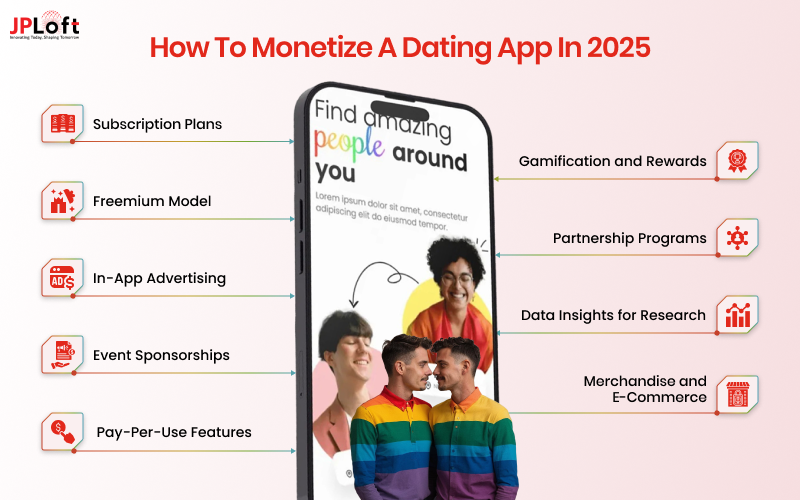
Here are the key monetization methods, explained in detail:
► Subscription Plans
One of the most popular monetization models for dating apps, subscription plans provide users access to premium features.
Offer tiered plans like monthly, quarterly, or yearly subscriptions to cater to different budgets.
Include exclusive features such as advanced matching algorithms, ad-free experiences, or priority visibility.
For example, apps like HER and Grindr offer premium plans like HER Premium and Grindr XTRA, providing users additional benefits like unlimited swipes or profile boosts.
► Freemium Model
Allow users to access basic features for free while charging for premium upgrades.
Include features like advanced filters, profile customization, and unlimited messaging in the paid version.
The freemium model attracts a larger audience by offering a free entry point, while enticing users to upgrade for an enhanced experience.
► In-App Advertising
In-app ads can generate consistent revenue while keeping the app free for users.
Use targeted advertising to promote LGBTQ-friendly brands, events, or products relevant to your audience.
Ensure ads are non-intrusive by integrating them seamlessly into the user interface, like banners or story ads.
Collaborate with brands to create sponsored content that resonates with your user base.
► Event Sponsorships
LGBTQ-focused events, both virtual and in-person, can be sponsored within your app.
Host community events, webinars, or pride celebrations and invite brands to sponsor them.
Promote sponsored events through push notifications, banners, or dedicated event sections in the app.
This approach fosters community engagement while offering a significant revenue stream.
► Pay-Per-Use Features
Charge users for one-time features without requiring a subscription.
Popular pay-per-use features include:
- Profile boosts to increase visibility for a limited time.
- Super likes or priority messages to grab attention from matches.
This model works well for users who want premium benefits without committing to a subscription.
► Gamification and Rewards
Introduce in-app games or challenges that encourage user engagement.
Offer virtual items, badges, or credits as rewards that users can purchase or unlock through activity.
For example, users could earn or buy badges that improve their profile ranking or highlight their profiles in searches.
► Partnership Programs
Collaborate with LGBTQ-friendly businesses or organizations to promote their services in your app.
Use affiliate marketing to generate income from every purchase or signup made through your platform.
Highlight these partnerships as resources for your users, such as discounts on LGBTQ-friendly travel, events, or products.
► Data Insights for Research (With Consent)
Aggregate anonymous data insights for market research purposes, provided users opt-in and data privacy standards are met.
This method allows researchers or companies to understand trends within the LGBTQ community without compromising user trust or safety.
► Merchandise and E-Commerce
Sell branded merchandise or products directly through your app.
Offer items like pride-themed apparel, event tickets, or dating-related accessories.
Integrate e-commerce features into the app to make the shopping experience seamless.
Choosing the right monetization strategy for your LGBTQ dating app depends on your target audience and app goals.
A combination of subscription plans, targeted ads, and unique pay-per-use features ensures profitability while maintaining a great user experience.
By prioritizing user value alongside revenue generation, your app can achieve sustainable success.
Partner with JPLoft – Your Trusted LGBTQ Dating App Development Company
Looking to create a dating app for LGBTQ users that stands out? JPLoft is here to make your vision a reality. Being a top dating app development company, we specialize in crafting inclusive, secure, and feature-rich platforms tailored to the LGBTQ community.
At JPLoft, we don’t just build apps, we create experiences. Our team of developers and designers understands the unique needs of the LGBTQ audience, ensuring your app offers inclusivity, safety, and unmatched usability. From AI-powered matching to robust security protocols, we deliver scalable solutions that set your app apart.
Whether you’re exploring the steps to develop a dating app for LGBTQ users or planning to launch an MVP, our end-to-end services cover everything from market research and design to testing and post-launch support.
Ready to build the next big thing? Partner with JPLoft, the trusted dating app development company, and turn your idea into a thriving reality.
Conclusion
Building a successful LGBTQ dating app is more than just creating a platform, it’s about fostering a community where users feel valued, included, and safe.
With rising demand and the opportunity to address unmet needs in the market, now is the perfect time to develop a dating app tailored to the LGBTQ community.
Take the leap, and create a platform that makes meaningful connections while generating lasting value.
FAQs
The cost typically ranges from $30,000 to $150,000, depending on the features, complexity, and platform (iOS, Android, or both). A basic app will cost less, while a highly customized app with AI-driven features and advanced security will fall on the higher end.
Key features include customizable gender and orientation options, secure messaging, location-based matching, profile verification, and advanced safety measures like reporting and blocking tools. Adding features like video calls, social feeds, and gamification can further enhance the user experience.
The development timeline varies based on the app’s complexity but typically takes 4 to 12 months. This includes planning, design, development, testing, and deployment.
LGBTQ users often face unique challenges on mainstream dating platforms, including a lack of inclusivity and safety. Developing a dating app for LGBTQ users addresses these needs, fosters trust, and taps into a growing, loyal market segment.
Monetization strategies include subscription plans, freemium models, in-app ads, pay-per-use features, event sponsorships, and e-commerce integrations. A combination of these strategies can ensure steady revenue growth.
Work with legal and compliance experts to meet standards like GDPR for data privacy, ADA for accessibility, and local laws for monetization and content. Implement explicit user consent and data protection measures to maintain user trust.
LGBTQ dating apps focus on inclusivity, safety, and community engagement. They offer features like customizable profiles for gender and orientation, advanced safety tools, and community-building options, which are often missing in traditional apps.





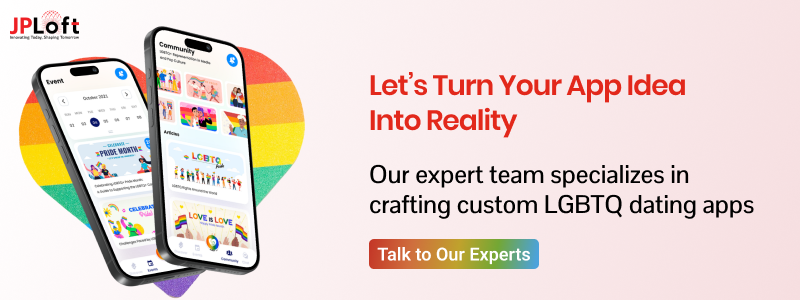

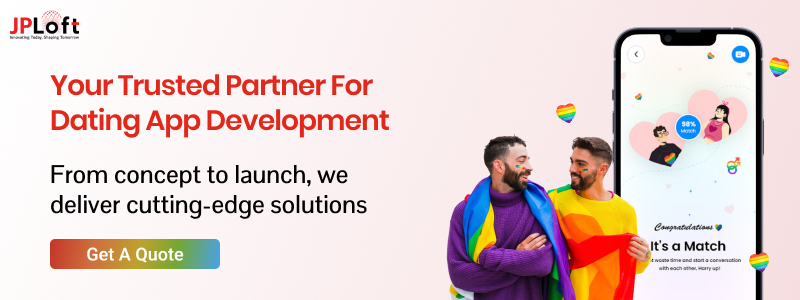

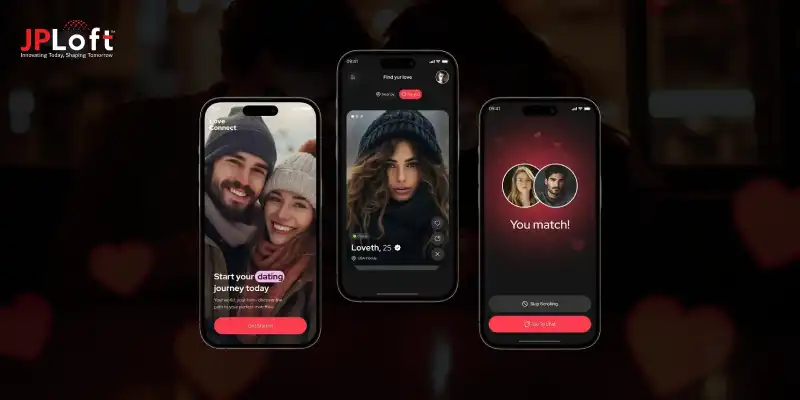
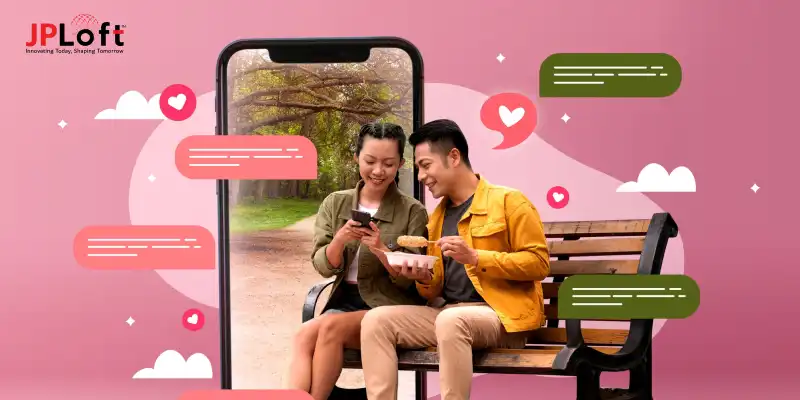
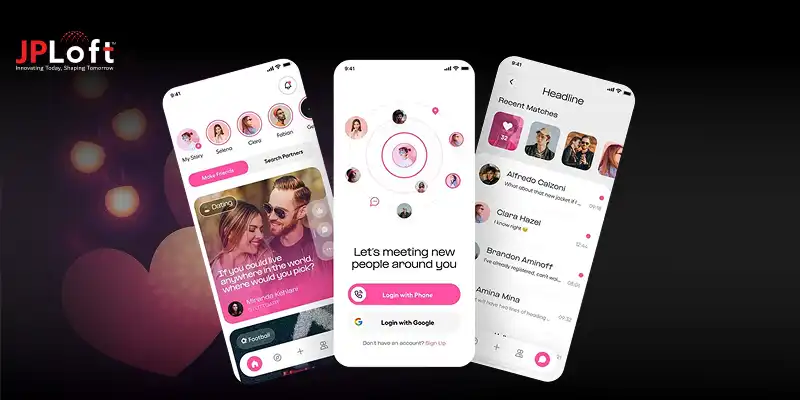


Share this blog